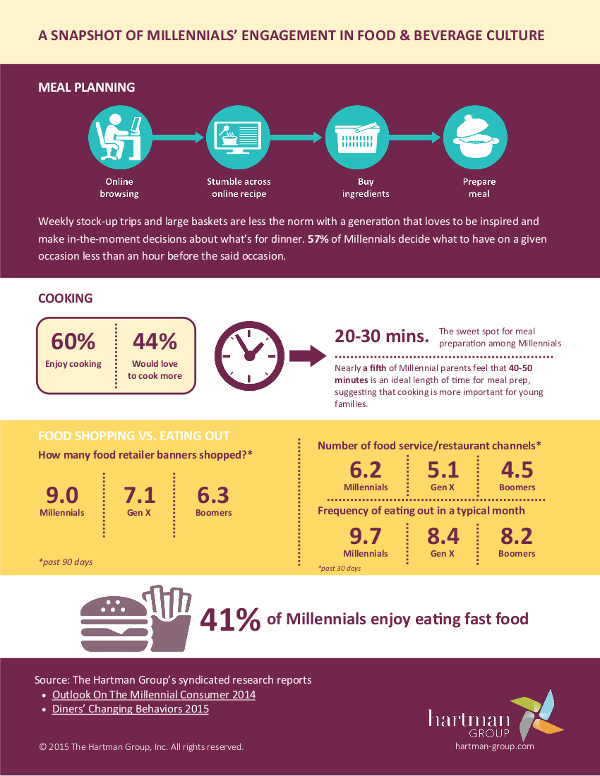Millennial Food Shoppers And Diners: Spontaneous. Flexible. Contradictory.
 Millennials are more spontaneous and adventurous than previous generations in their interactions with food and beverage. Like other generations of consumers, they are complex and full of contradictions — contradictions they are fully aware of and embrace. Irony is very much their preferred form of self-expression.
Millennials are more spontaneous and adventurous than previous generations in their interactions with food and beverage. Like other generations of consumers, they are complex and full of contradictions — contradictions they are fully aware of and embrace. Irony is very much their preferred form of self-expression.
Millennials don’t think contradictions make them hypocritical. They are eager to share all aspects of who they really are and don’t worry if the pieces don’t quite add up. In fact, they love the playful ironies their contradictions communicate. They are just as likely to seek out fresh local foods as they are to eat at a fast food restaurant.
Reflecting their overall youthfulness, things like enjoying more time alone, wanting smaller groups of closer friends and valuing face-to-face interactions, Millennials’ strong ties to technology and new ways of engaging with food and beverage occasions make this generation’s shopping and dining habits worth watching not just for clues about what young adults want but for ways that Millennials are influencing changes for other generations.
The following infographic provides a glimpse into the ways that Millennials’ food shopping and eating away from home behaviors are unique.
Click to view full image (PDF)
When compared to other generations, Millennials are also more likely to:
- Be gender neutral when it comes to the role of cooking (61 percent of females and 60 percent of males enjoy cooking)
- Consider food an adventure and seek out different, ethnic and artisanal foods (40 percent like to try new kinds of ethnic cuisines and “anything new and different,” compared to 34 percent and 32 percent respectively of Gen X and Boomers combined)
- Make spur-of-the-moment food decisions and have less well-stocked pantries
- Blend sauces and infuse flavors to customize new salad dressings and marinades
- Trend towards more meatless eating, with 6 percent identifying as faithful vegetarians, compared to 5 percent of Gen X and Boomers combined. And, 12 percent report often going vegetarian, compared to 10 percent of Gen X and 5 percent of Boomers
- Purchase frozen and pre-packaged foods they consider healthy, adding additional seasonings and fresh ingredients
The Age-Old Marketing Question: How To Reach Millennials?
In marketing years, Millennials seemingly have been around for longer than their age might suggest. This generation has been the beacon of hope for the future of brands and companies, and the focus has shifted from the future to the here and now as Millennials are well into adulthood.
Here are a few thoughts on how to connect with Millennials for food retailers, food service and restaurants.
- It’s important to curate a product selection that appeals to young adults on the move who have an interest in cooking and yet are more likely than other consumers to want to “eat out.”
- To meet these needs, providing prepared foods with “food-forward” characteristics (e.g., ethnic, natural, fresh) as well as a variety of snacks for eating-out (or in-store) occasions is an important consideration.
- New flavors and ingredients linking to global cuisines are of high significance to Millennials.
- Signage, narratives, food merchandising and in-store programs that highlight new food experiences are significantly important.
- Millennials lead the way in favoring natural and organic ingredients, products that are locally grown and/or made and those free of GMOs and allergens.
- More broadly, Millennials favor fresh, prepared and convenient foods — like other consumers, but often more so.
- Millennials rely on frozen meals more than older generations, thus representing yet more potential for in-store experience in terms of sampling.

